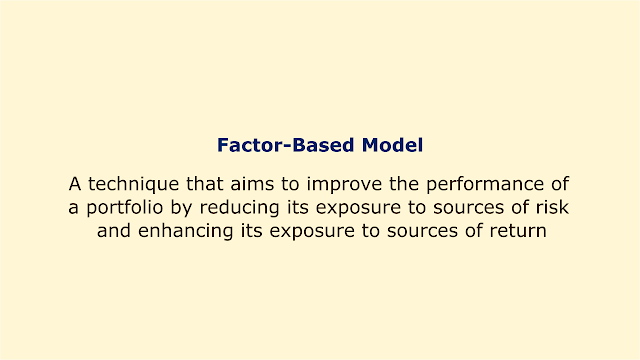 |
| Image: Moneybestpal.com |
Factor-based model optimization is a technique that aims to improve the performance of a portfolio by reducing its exposure to sources of risk and enhancing its exposure to sources of return.
Factors are variables that explain the common variation in asset returns, such as market, size, value, momentum, quality, and volatility. By using factors, investors can construct portfolios that target specific risk-return profiles and diversify across different sources of return.
Factor identification and portfolio generation are the two key processes in factor-based model optimization. Finding the components that most effectively account for the variation in asset returns is the process of factor identification, which can be done using either statistical techniques or economic intuition. Without making any presumptions, statistical techniques like principal component analysis (PCA) or autoencoder neural networks extract components from the asset return data. On the other hand, economic intuition chooses elements like macroeconomic variables or fundamental traits that have a credible relationship to asset returns based on economic theory or empirical data.
Portfolio construction is the process of allocating weights to the factors and the assets within each factor, using either a top-down or a bottom-up approach. In a top-down approach, weights are first assigned to the factors according to their predicted returns and risks, and then to the assets inside each component according to their factor exposures or loadings. In a bottom-up approach, the assets with the highest factor exposures or loadings are first chosen, and weights are subsequently assigned to them based on the predicted returns and risks.
Compared to conventional approaches of portfolio optimization, factor-based model optimization offers a number of benefits. First, it decreases the problem's dimensionality, making it simpler to manage extensive and intricate portfolios. Second, it strengthens the portfolio's stability and robustness, as factors have a tendency to be more enduring and less correlated than individual assets. Third, it improves the portfolio's interpretability and transparency because components can offer simple justifications for the performance and risk of the portfolio.
Factor-based model optimization, however, also has significant drawbacks and restrictions. The first step in this process is to estimate the factor model parameters accurately. These parameters, such as factor loadings, factor returns, and factor covariances, might be impacted by estimating mistakes, model misspecification, or concerns with the quality of the data. It also entails making trade-offs between several goals, such as increasing returns, lowering risks, regulating turnover, or meeting restrictions, which might result in less-than-ideal or ineffective solutions. Thirdly, it is dependent on the accessibility and validity of the factor data, which can differ among markets, locations, or asset classes.
As a result, factor-based model optimization is not a universally applicable method for portfolio management. The criteria and optimization techniques must be carefully chosen to meet the investor's goals, preferences, and limits. In order to take into account shifting market conditions and investor expectations, it also necessitates routine monitoring and updating of the factor model parameters and the portfolio weights.
Factor identification and portfolio generation are the two key processes in factor-based model optimization. Finding the components that most effectively account for the variation in asset returns is the process of factor identification, which can be done using either statistical techniques or economic intuition. Without making any presumptions, statistical techniques like principal component analysis (PCA) or autoencoder neural networks extract components from the asset return data. On the other hand, economic intuition chooses elements like macroeconomic variables or fundamental traits that have a credible relationship to asset returns based on economic theory or empirical data.
Portfolio construction is the process of allocating weights to the factors and the assets within each factor, using either a top-down or a bottom-up approach. In a top-down approach, weights are first assigned to the factors according to their predicted returns and risks, and then to the assets inside each component according to their factor exposures or loadings. In a bottom-up approach, the assets with the highest factor exposures or loadings are first chosen, and weights are subsequently assigned to them based on the predicted returns and risks.
Compared to conventional approaches of portfolio optimization, factor-based model optimization offers a number of benefits. First, it decreases the problem's dimensionality, making it simpler to manage extensive and intricate portfolios. Second, it strengthens the portfolio's stability and robustness, as factors have a tendency to be more enduring and less correlated than individual assets. Third, it improves the portfolio's interpretability and transparency because components can offer simple justifications for the performance and risk of the portfolio.
Factor-based model optimization, however, also has significant drawbacks and restrictions. The first step in this process is to estimate the factor model parameters accurately. These parameters, such as factor loadings, factor returns, and factor covariances, might be impacted by estimating mistakes, model misspecification, or concerns with the quality of the data. It also entails making trade-offs between several goals, such as increasing returns, lowering risks, regulating turnover, or meeting restrictions, which might result in less-than-ideal or ineffective solutions. Thirdly, it is dependent on the accessibility and validity of the factor data, which can differ among markets, locations, or asset classes.
As a result, factor-based model optimization is not a universally applicable method for portfolio management. The criteria and optimization techniques must be carefully chosen to meet the investor's goals, preferences, and limits. In order to take into account shifting market conditions and investor expectations, it also necessitates routine monitoring and updating of the factor model parameters and the portfolio weights.
